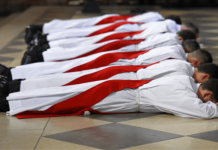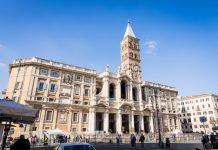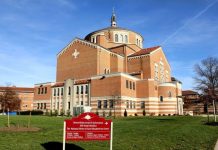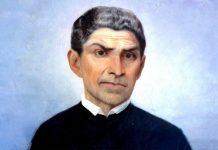On account of her incredible virtues and her apostolate, Queen Margaret, great-niece of St. Edward the Confessor, the King of England, became Patroness of Scotland.
Newsroom (24/12/2022 1:49 PM, Gaudium Press) St. Edward was born in England in 1003. When that nation was conquered by Canute the Great, Edward, while still a boy, went into exile in Normandy, under the rule of his uncle Richard II, Duke of that region of northern France.
Initially, he worked as a shepherd. At the age of 18, by that time a knight, he distinguished himself for his excellent military qualities in various battles and was given the government of a province under the title of Count.
St. Edward the Confessor
Canute having died, his son called Edward back, who then became King of England in 1042. He married Edith, of high nobility; they had no children, because they had both taken a vow of virginity and honoured it completely. St Edward died in 1066 and was buried in Westminster Abbey, which he had had built.
His body was discovered to be incorrupt in 1102, and many miracles took place in its presence. He received the title of “Confessor” for having heroically confessed the Catholic Faith before God and men. His memory is celebrated in the Church on 5 January.
Soon after his death, war broke out between two pretenders to the throne of England: Count Harold, chief of the Saxons, who had himself crowned king, and William, Duke of Normandy, grand-nephew of St. Edward, whom Edward had indicated as his successor.
Harold himself had previously been in Normandy and had taken an oath, before the relics of Saints, that he would always defend William’s right to the English Crown.
William, Duke of Normandy, turned to Pope Alexander II, who declared that he, William, was the successor of St. Edward and sent him a standard, the symbol of royalty.
William the Conqueror
Archdeacon Hildebrand -the future Saint Gregory VII and Pope Alexander II’s adviser – encouraged Pope Alexander II to support William in his military bid to conquer England.
William appealed to the whole of France and managed to gather 60,000 men and 750 ships; many horses were also transported. They crossed the English Channel and reached the south of England.
William’s and Harold’s armies clashed in October of 1066 in the vicinity of Hastings. Most of the night before the final battle, the Saxons spent singing and drinking, while the Normans remained in prayer and confessed so that they could take Communion at the Mass that was celebrated the next morning.
Just before the fighting began, William’s warriors sang the Chanson de Roland, which recalls the heroism of Charlemagne and his peers. At the end, they shouted “God help us!” and launched themselves against the Saxons, who were massacred by the Normans, whose cavalry was very effective; Harold was among the dead.
In 1070, three legates of Pope Alexander II crowned William King of England and he went down in history as the “Conqueror”. He subsequently had a monastery built on the site of the battle.
With the support of the new monarch, the legates excommunicated the ecclesiastics who held high positions in the Church. The Conqueror worked to get Norman clerics to occupy the principal episcopal seats of England, and French became the country’s official language. But he was not entirely faithful to the Church: he appointed bishops without consulting the Pope.
He raised the cultural and spiritual level of the people
In that same year, 1070, St. Margaret – born in Hungary and descended from a monarch of England – married Malcolm III, who had killed the King of Scotland, Macbeth, and assumed the throne of that nation. Shakespeare actually wrote a play entitled Macbeth.
Malcolm was a semi-barbaric man, and St. Margaret taught him Catholic doctrine and somehow managed to civilize him.
In 1093, walking along a road unarmed, he was attacked by a group of individuals, directed by one of his nephews, who murdered him.
Malcolm and Margaret had eight children. Three of them were kings of Scotland, and one daughter became Queen of England by her marriage to Henry I, son of William the Conqueror.
As a great admirer of the Liturgy, St. Margaret introduced beauty into court life as an indispensable means of raising the cultural and spiritual level of the people. She established that the Royal Family should be served at table with gold and silver tableware.
She led a life of intense prayer and fasted frequently, and cared for the destitute with special zeal and affection. During Lent, she would attend to the poor in the royal palace and serve them. St. Margaret “regarded the kingdom of Scotland as a large family of which she was the mother.”
Three months after the death of her husband, Saint Margaret gave her soul to God.
Sacralization of regal dignity
Regarding her, Dr. Plinio Corrêa de Oliveira commented:
“In the life of St. Margaret of Scotland, one notes the existence of the marvelous in the Middle Ages. Not of the marvelous as a fable or legend, but as something realizable.
“To the brawny Scotland, then a mission land, this princess came bringing illustrious blood, all the flower of Western civilization, becoming a magnificent queen, leaving several children illustrious for their virtues, and who interceded on behalf of the people, gave alms, and performed miracles.
“All this was always anointed by the Royal Crown, besides a complete idea of royalty, and presents a concrete world where wonders are possible and the extraordinary, the stupendous, the order, even the most excellent and audacious, are achievable on earth.
“Saints like this spread the good odour of Jesus Christ so much, everywhere, that they ended up sacralizing the regal dignity itself and creating a kind of atmosphere of the marvel of medieval civilization, in which the stained glass windows are a reflection – presenting the blessed amidst pieces of golden glass, ruby-coloured, emerald-coloured, with a light over their heads – the Royal Crown on a table, a Saint pouring flowers around herself.
“All this is the image of the very way in which the medieval civilization conceived the life, for example, of St. Margaret, Queen of Scots.”
Let us ask St. Margaret, whose memory we celebrate on 16 November, to obtain from Our Lady, graces for us to always be turned towards the marvelous, in order to act effectively in the face of today’s world, which is hurtling towards the hideous.
By Paulo Francisco Martos
Compiled by Sandra Chisholm


































